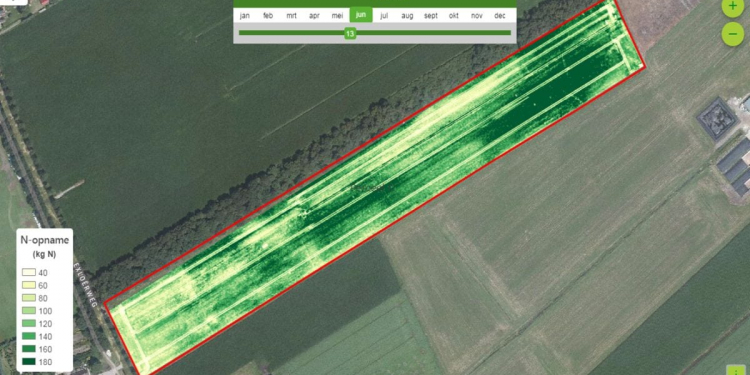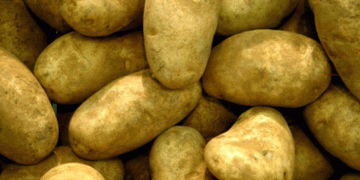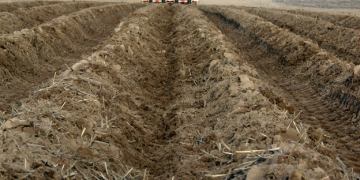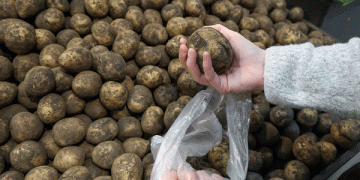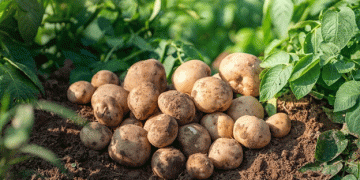Researchers from Aarhus University have tested the use of satellite and drone imagery to predict and forecast water and nitrogen status in potatoes grown in Denmark.
The first potato tuber in Denmark was planted in the Royal Botanical Garden in 1642. Less than 100 years later, Danish farmers began to grow the tuberous vegetable, which quickly became a favourite on the Danish dinner tables. The potato yield in Denmark is high, in some years even twice as high as the average European yields. Yet, potatoes are sensitive to the lack of water and nitrogen (N) that can accompany a more variable climate. Researchers from Aarhus University, among others, have investigated methods to better assess water and N status of the plant to avoid over- or under-supply. The hope is to optimise potato production and thus reduce losses.
“Our main objective was to investigate the potential for integrating sensors and data collection strategies into existing operational services. In this way, based on better geographical information, we will be able to improve the advice on irrigation and fertilization to the potato farmers. In addition, we wanted to improve accuracy and increase adoption rate among farmers”, says Professor Mathias N. Andersen from the Department of Agroecology at Aarhus University, who led the study in Denmark.
Drones and satellites
As part of a project called “POTENTIAL – Variable rate irrigation and nitrogen fertilization in potatoes: engage the spatial variation”, the researchers have collected and combined data from, among others, Sentinel-2, a satellite from the EU Copernicus program. The choice fell on Sentinel-2 due to free access to data, high spatial resolution and furthermore the satellite visits the same area after short period of time – up to 5 days.
“It can be very cloudy in the northern European sky, even in the summer when the potatoes are growing. The clouds can blur images from satellites quite a bit. That is why we have chosen to supplement with drones. They can move underneath the clouds, and they are also both cheap and flexible to use”, says researcher Kiril Manevski from the Department of Agroecology.
“We have compared data from satellite and drones in an environmental analysis and constructed a growth model for plant growth affected by abiotic factors. We found that maximum air temperature significantly limits plant growth, while diffuse radiation due to interactions between solar radiation, atmospheric aerosols, and clouds stimulates growth by providing energy for photosynthesis in the lower leaf layers. Diffuse radiation is much greater in the higher latitudes, which are also significantly cloudier compared to the sunnier regions in the lower latitudes”, says PhD student Junxiang Peng from the Department of Agroecology.
“The growth model for calculating potato growth captured this variation very well using both Sentinel-2 and drone data”, he continues.
Potato nitrogen status can be measured in great detail
“We chose potatoes as a test crop, as it makes it easier to measure both above- and belowground biomass, i.e. net primary production. However, we are sure that it is possible to apply the procedure to other crops as well”, says Kiril Manevski.

It is important to be able to identify the nitrogen status of the crops to know whether they need to be fertilised or not, both in relation to precise agricultural management and protection of the environment. By comparing conventional (parametric) and more ‘flexible’ (non-parametric) statistical models, the researchers conducted a further in-depth analysis of the drone and Sentinel-2 data. The result from each model and data type was used to calculate nitrogen requirements, i.e. the question of where and how much fertilizer nitrogen the potato needs at any time of the season.
“We were surprised to see that the predictive accuracy of the nirogen status of the potatoes was highly accurate with the non-parametric model. In this case, we had compared the ‘random forest’ regression with the conventional models, for both drone and Sentinel-2 data”, says Junxiang Peng, adding that the result is crucial for the estimation of the potato nitrogen need.
Can drought stress be detected using a “false signal” for nitrogen requirements?
In a perfect world, one would be able to estimate nitrogen and water needs of the plant accurately, but the challenge is that each season is different. For example, the summer of 2017 was wet and cool over large parts of Northern Europe, whereas 2018 was among the driest and warmest in recent decades for the study of drought stress, with temperatures in the season in Denmark of 28 degrees. In fact, the potato yield was significantly reduced, and not even some irrigation improved the situation.

“The study has shown us that potatoes under drought stress show nitrogen deficiency, while in reality there is a lot of nitrogen in the root zone, the plant is just not able to utilise it. When the drought stress stops, nitrogen uptake resumes, although production loss is irreversible. We are now left with the question of whether this “false signal” can be of any use in terms of detecting drought stress earlier and thus improving irrigation management in the dry days. We continue to work on supplementing the results with thermal data, i.e. changes in temperature anomalies over agricultural land. There is a very promising combination of reflective and emissive data that we can use to detect and manage drought stress”, concludes Kiril Manevski.
